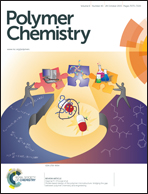The effect of with/without resonance-mediated interactions on the organic solar cell performance of new 2D π-conjugated polymers†
Abstract
With the goal of discovering a new and plausible approach to utilizing the conjugated side chains (CSCs), other than for the previously reported purpose of two-dimensional (2D) π-conjugation extension in π-conjugated polymers, we report, for the first time, the impact of with/without interactions induced via resonance in CSCs on the molecular weight (Mw) and photovoltaic performance of polymers. For this, we designed two donor (D)–acceptor (A) polymers, represented as PBDTBPA(H)-DPP and PBDTBPA(F)-DPP, containing alkoxy-BPA(H) and alkoxy-BPA(F) [BPA = biphenylethynyl] on the benzodithiophene (BDT) unit as novel CSCs, respectively. The introduction of these CSCs generated bis-tolane as an integrated part of the BDT unit, which allowed us to address the difference in the polymerization, photophysical, and photovoltaic properties of PBDTBPA(H)-DPP and PBDTBPA(F)-DPP, as a function of the structural variation of CSCs, which has never been investigated in organic solar cells (OSCs). In contrast to the weak electron-donating nature of BPA(H), BPA(F) exhibited a strong electron-donating ability due to the interaction of the lone pair electrons of the fluorine atom with the triple bond via resonance, which decreased the rigidity of the triple bond, whereas in PBDTBPA(H)-DPP the rigidity of the triple bond was retained with no such interaction. The striking differences in the rigidity and different electron-withdrawing tendencies of the CSCs were well correlated with Mw and with the highest occupied molecular orbital (HOMO) energy levels of the polymers. As a result, the inverted OSCs based on PBDTBPA(H)-DPP achieved an open-circuit voltage (Voc) of 0.74 V, and power conversion efficiency (PCE) of 5.58%, which was 38% higher than that of PBDTBPA(F)-DPP-based inverted OSCs. More significantly, the inverted OSC devices were highly stable, retaining 80% of their original PCE after 60-day storage in air, even without encapsulation. To the best of our knowledge, this 5.58% is the highest PCE reported to date for the arylethynyl-substituted BDT donor-based OSCs. These results reveal that bis-tolane [BDTBPA(H)] as an integrated part of the new BDT unit is a promising donor building block for high Mw donor polymers in addition to 2D extended π-conjugation for high performance bulk heterojunction (BHJ) OSCs.


 Please wait while we load your content...
Please wait while we load your content...